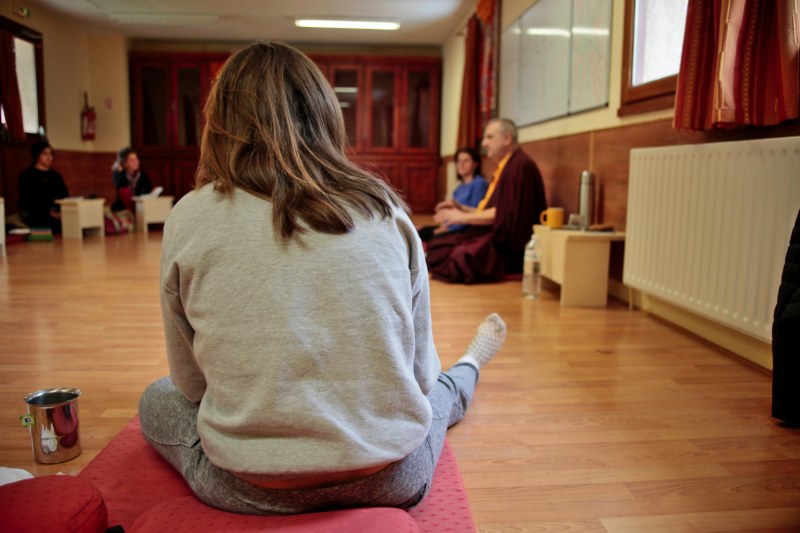With a Wish to Continue Exploring – Chronicle of the Young Adult Course 2019

Ten girls brought the young adult course to life this year. Not a single guy! Other than myself who was guiding along with Emmanuelle. In response to the unlikely opening question, “Are you here?” the answers varied and complemented one other.
“Yes, totally. When I’m here, I’m here!”
“Sort of. My body’s here, but my mind isn’t totally here yet.”
“I’m distracted by what I was doing before.”
“I’m here in the present, but I’m also a little bit in the past and already in what is coming next.”
And a final conclusion, “You asking the question allowed me to get here.”

When I ask them what they came looking for, a certain direction appears: more relaxation, clarity, an anchor, discernment, different perspectives, new questions, release, and…fun. With a final request: to eat well, too! We can do our best to respond to the first bunch of expectations, but the last isn’t up to us. Better talk to the kitchen team.
Now that we have clarified expectations and gotten into the groove, we set off on a discovery of ourselves, alternating role-playing, discussions, meditation, sharing, and breaks. Of course, we start the party with the theme of impermanence. We set out to find something that is not impermanent. Initially, we don’t find anything, but over the course of the discussion, doubt creeps in. “I still somehow feel like even though everything in me changes, there is a central core that is stable and remains the same.” Things start off strong! Nonetheless, we set the question aside for the moment in order to focus on impermanence and its consequences. Our resistance to change naturally comes up. Change itself is not the problem; it’s how I experience it. Just like that, our exploration leads us to dukkha, suffering.

Things get denser as we take the time to unpack the idea of suffering and its many facets. One observation is reassuring: suffering is natural in the sense that everyone faces it, and it is the result of causes and circumstances. Therefore, it is something we can work with. Causes and circumstances? What are the roots of unhappiness and dissatisfaction? Everyone agrees: emotions (several of the girls come from Buddhist families). This leads us to delving into our emotional functioning with an essential question. Are emotions good or bad, beneficial or harmful?
It so happens that this is not a useful approach. Whether emotions are beneficial or not, they are the fruit of something else—a result (we will talk about karma later). So the question becomes, “How do I recognize them and what do I do with them?” And S.N.A.P! When the emotion arises, we practice Seeing, Naming, Accepting, and Perspective-shifting. This first part of the course allowed us to identify the Four Truths of the Noble Ones. Now all we have to do is name them: suffering and the causes of suffering, cessation and the path to cessation.

When we start up again, the foundations are in place, and we can get into the details. We work on decrypting our functioning: pleasant and unpleasant sensations, I like, I don’t like, attachment and aversion, fear, jealousy, pride, judgments, and what to do with it all. Each person brings their own experiences, questions, memories, disagreements, nuances, and resources. The discussion rolls along smoothly and a form of clarity appears, but, of course, questions remain. The day comes to a close. We find the energy to sit and remain quiet this time. The meditation at the end of the day does us good. It helps bring calm and clarity. But we can feel the fatigue for sure. See you tomorrow…
We start the day with a meditation session. It is clearer and easier than the day before. Emmanuelle guides, and the practice becomes an exploration. “I am going to ring the gong and, from there, don’t think about anything, ok?” Everyone says ok. She repeats the instructions and, just before ringing the gong, she says, “Don’t think about anything, not even a strawberry!” Dong… Silence for a time. Dong…
The feedback is clear:
“I kept telling myself, ‘Don’t think about anything; don’t think about anything.’ But that’s thinking about something.” “I kept telling myself to stop thinking about the strawberry.” “In my case, I wound up thinking about an apple instead.” Everyone was united in their conclusion: it is not possible not to think about anything or, in any case, that is not meditating.

We come back to yesterday’s question: At the end of the day, what am I, and what is mind? Our exchanges are more rigorous. Mind is a continuum; it is aware but obscured. We have a potential within us. The qualities are already present; we must actualize them. We deal with karma as a dynamic with its own complexity. Karma is simultaneously a question of the moment—the actions that I commit in every instant—and also a longterm affair—tendencies that take time to ripen. This brings us back to practice: to cultivating the ability to be present with ourselves, aware of our states of mind, and attentive to the actions that we commit.

We conclude this second day with the instruction that brings together the essentials of the dharma: Give up causing harm, carry out beneficial actions, and master your mind. A question arises, “What do I do when I realize that I have caused harm?” To avoid falling into a narrow and dogmatic approach, we focus on the idea of training, of things as a process, and of readjustment. In addition to key dharma ideas, the group has understood the dynamic we use: listening on its own is not enough; reflection allows us to understand and application helps us gain experience. We all left with a wish to continue exploring.
Puntso, program director for Dhagpo
